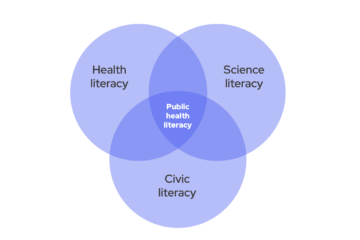
More than half a million local officials collectively control over $2 trillion in spending. That money pays for everything from schools to transportation to housing to healthy food, yet the officials who make these decisions are typically elected by less than a quarter of the public. Increasing voter turnout can benefit residents, local leaders, and public health.
People who report better overall health are more likely to be consistent voters. Surprisingly, the reverse may be true as well: voting might actually make people healthier. While not directly correlated to health outcomes, voting can give people a sense of belonging within their community and a connectedness to their representatives. People who experience this social cohesion are more likely to live longer, happier lives, and advocate for better conditions by voting more consistently. In short, voting and health have a cyclical relationship rooted in a sense of belonging and autonomy.
Understanding low turnout is the first step toward finding a remedy. Voting patterns vary across age, ethnicity, and socioeconomic status, resulting in officials often being elected by people who are older, whiter, and more affluent than their full constituency. This is pattern is even more evident at the local level than in state or nationwide races.
While some people report that they do not vote because of distrust or disillusionment in government, low turnout is often a result of barriers to voting rather than disinterest. Young and low-income city residents tend to move more frequently than their older and higher-income counterparts, oscillating between different jurisdictions’ registration processes and sometimes never bothering to register at all.
There are also well-documented examples of voter suppression across the country, including stringent voter ID laws, restricted access to early or mail-in voting, prohibitive fines and fees, felony disenfranchisement, lack of translated voting materials, and reduced polling locations. In almost all cases, these barriers disproportionately affect people and communities of color.
While cities are often preempted from implementing voting reform (because elections are largely run by states), voting is just one tool. Civic engagement and participation in the political process also encompass engaging in community meetings and activities, volunteering, and other forms of political expression. Despite barriers to voting reform, city leaders have a number of tools in their purview to increase voter turnout and improve social cohesion.
Enhance voter engagement through local advocacy
Cities do not need to overhaul the entire elections system to encourage participation and educate voters. City officials can distribute educational materials and update government websites to include information about where and how to vote. Citywide campaigns that set voter participation goals and recognize local organizers can help inspire participation. Cities can utilize tactics that target certain demographics, such as social media campaigns that aim to reach younger voters. There are also multiple national initiatives like Civic Cities that encourage mayors to increase voter turnout by mobilizing local leaders and committing to sharing successful practices with each other. Landlords can be a great resource to engage new city residents by requiring them to provide new tenants with voter registration and education forms. This is particularly useful in cities with highly transient populations like those with large college and university populations. Finally, it is crucial that all voter engagement initiatives be executed in multiple languages. Multilingual materials are essential to reach all potential voters and encourage participation from immigrant and non-English speaking communities.
Waive public transportation costs
Cities can facilitate easier access to the polls by offering free or reduced fares for public transportation on election day. Los Angeles offers free metro rides on election days, as well as 30 minutes free on Metro Bike Share bicycles. Other cities, including Dallas and Tampa, offer free rides to passengers who show a valid voter registration card.
Extend polling hours
Some states, including Idaho, Georgia, Kansas, and Massachusetts, grant cities discretion to open polls earlier or close polls later than the official state polling hours. Extended hours particularly benefit hourly wage earners and others in jobs that do not offer flexibility on voting day.
Transition to mail-in municipal elections
When an election is exclusively local, cities have more autonomy than when statewide races are also on the ballot. Anchorage, Alaska, transitioned municipal elections to an entirely mail-in system, resulting in more votes being cast in the first year than ever before.
Align local races with statewide races
Most U.S. cities hold their mayoral races in odd-numbered years. The competition for media attention during that cycle is lower, but so is voter turnout. If mayoral elections were shifted to even-numbered years, it’s likely that many more voters would head to the polls, as was the case when California aligned its local elections to even-numbered years in 2018. Moving mayoral elections often requires a change in the city charter, which must be approved by voters, and there are logistical considerations around shortening or lengthening a current mayoral term. Still, evidence indicates that turnout for local elections will grow by large margins if they coincide with national elections.
The bottom line: Increasing voter turnout can ensure that more voices are counted, and better elected representation can lead to healthier communities.
Kate Conquest, MPH, is a program associate for CityHealth.




